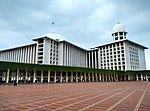Wahid Hasyim
This article needs additional citations for verification. (November 2014) |
This article includes a list of general references, but it lacks sufficient corresponding inline citations. (November 2014) |
Wahid Hasyim | |
|---|---|
 Wahid Hasyim, c. 1950's | |
| 1st Minister of Religious Affairs | |
| In office 30 September 1945 – 14 November 1945 | |
| President | Sukarno |
| Preceded by | None, new term |
| Succeeded by | Rasjidi |
| In office 6 September 1950 – 3 April 1952 | |
| President | Sukarno |
| Preceded by | Masjkur |
| Succeeded by | Fakih Usman |
| In office 20 December 1949 – 6 September 1950 | |
| President | Sukarno |
| Preceded by | Masjkur |
| Succeeded by | Masjkur |
| Personal details | |
| Born | 1 June 1914 Jombang, East Java, Dutch East Indies |
| Died | 19 April 1953 (aged 38) Cimahi, West Java, Indonesia |
| Cause of death | Traffic collision |
| Nationality | Indonesian |
| Spouse | Solehah binti K.H. Bisri Syansuri |
| Children | K.H. Abdurrahman Wahid Aisyah Hamid Baidlowi K.H. Salahuddin Wahid dr. Umar Wahid, Sp.P Lily Chodijah Wahid Hasyim Wahid |

Abdul Wahid Hasyim (1 June 1914 – 19 April 1953) was the first Minister of Religious Affairs in the government of President Sukarno of Indonesia, a post he held in 1945, and from 1949 to 1952.
He was the son of Nahdlatul Ulama founder Hasyim Asy'ari and went on to lead the organization.[1] In the future his son, Abdurrahman Wahid, also held the same office in NU, and later was elected as 4th President of Indonesia in 1999.
One of the main roads in central Jakarta, Jalan Wahid Hasyim, is named after him.
Early life[edit]
Wahid was born in 1914 as a child of Hasyim Asy'ari and one of his wives, Nafiqoh.[2] Both Asy’ari and Nafiqoh hailed from ulema families in East Java. Wahid is Asy'ari's first-born male and his fifth child. He spent most of his childhood in Jombang, which included attending a pesantren that his father founded, Pesantren Tebuireng. By 1926, he had finished his schooling in Tebuireng and spent two years continuing his education in various East Java pesantren as was the tradition at the time.[3]
Following his hajj pilgrimage in 1932 with one his cousins, Muhammad Ilyas, Wahid spent two more years in Saudi Arabia to further his study of Islamic hadith and fiqh. On returning to Jombang, he made several education reforms to the pesantren his father owns, including incorporating a general education system alongside the Islamic one. His experience in Saudi Arabia also led him to start learning foreign languages, such as English, German, and Dutch.[3]
Personal life[edit]
Wahid married his cousin, Solehah, in 1939. He met Solehah in a wedding ceremony in the same year. From this marriage, the couple had six children: Abdurrahman Wahid, Aisyah Hamid Baidlowi, Salahuddin Wahid, Umar Wahid, Lily Chodijah Wahid, and Hasyim Wahid.[4]
Death[edit]
Wahid died following a traffic accident on 18 April 1953, where the vehicle that he was riding on collided with a truck in Cimindi. His son, Abdurrahman Wahid, and Argo Sutjipto, the secretary of the central board of Nahdlatul Ulama, were also occupying the vehicle during the incident. Wahid and Sutjipto were severely injured and it took four hours before they were able to be transported to the nearest medical center, Borromeus Hospital. Abdurrahman survived the crash, but Wahid died on April 19, followed by Sutjipto the very next day.[3]
References[edit]
- ^ National Information and Communication Agency 2001, p. 6
- ^ Center, Ulama Nusantara (2020-06-09). "Sepucuk Biografi Perempuan Hebat Pendamping Hadratussyaikh Hasyim Asy'ari 'Nyai Masruroh'". Ulama Nusantara Center (in Indonesian). Retrieved 2021-02-03.
- ^ a b c WAHID HASYIM: From Tebuireng for the Republic. Tempo Publishing. 2014-01-01.
- ^ antaranews.com (2020-08-01). "Berpulangnya sang bungsu putra KH Wahid Hasyim". Antara News. Retrieved 2021-02-03.
5. https://www.tebuireng.co/kh-wahid-hasyim-dalam-perjalanan-panjang-kemerdekaan/

